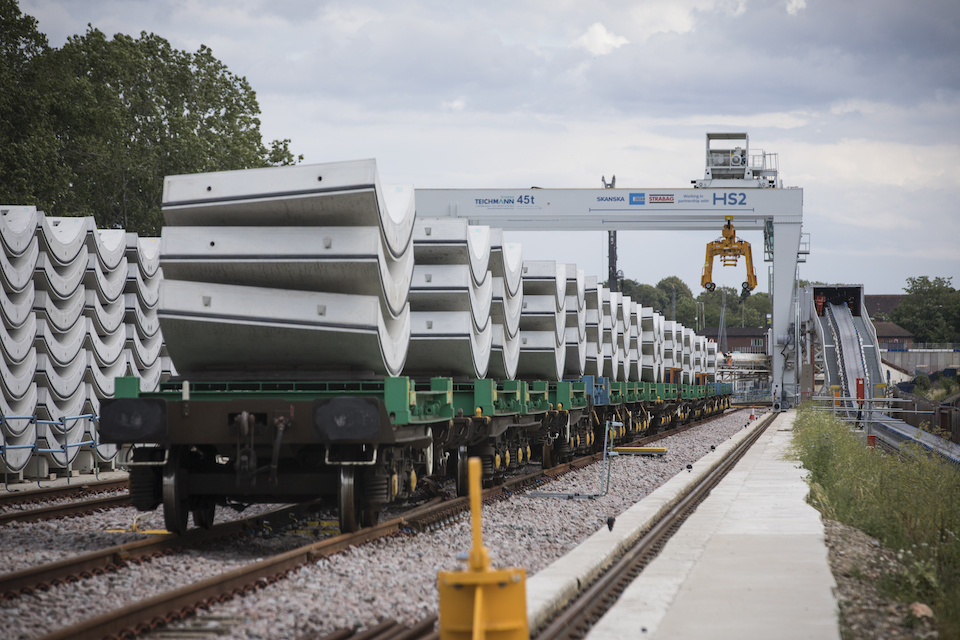HS2 tunnel rings by rail removes a million lorry miles from London

Britain’s high-speed rail project may have been in the news for all the wrong reasons lately. While work has been abandoned on the northern sections of the line, work continues on the core of the mammoth civil engineering project. Making all the right environmental news, the London to Birmingham railway construction company has highlighted their efforts to keep traffic and congestion off the UK roads. With much of the line going underground, HS2 has been using rail freight partners to deliver the vast number of prefabricated tunnel ring segments to their West Ruislip Portal site in Hillingdon, in northwest London.
Since February of this year, HS2’s London tunnels contractor, the Skanska Costain STRABAG joint venture, has received deliveries of tunnel ring segments on specially contracted freight trains. The prefabricated components form the permanent lining of the tunnels, currently being dug by the twin tunnel boring machines named Sushila and Caroline. HS2 Limited say their commitment to utilising rail or waterways for material transport whenever feasible has effectively removed one million miles (1,6 million km) of truck movements from Britain’s congested road network – much of that traffic removed from around London.
Twenty million tonnes by rail
Manufacturing partners Pacadar UK, operating from a factory on the Isle of Grain in Kent, is responsible for manufacturing the tunnel ring segments for HS2’s Northolt Tunnel West. The factory is served by its own rail facilities, ensuring efficient rail freight deliveries. Over 120 trains have completed the journey from the Isle of Grain to West Ruislip, averaging five trains per week. Each train on the fifty-mile (80km) journey carries 144 segments, contributing to the construction of over 20 completed tunnel rings upon underground installation.

“Our freight program is a result of extensive collaboration between HS2 Ltd, our contractors, Network Rail, and the freight operators”, explained Pat Cawley, HS2’s Director for On Network Works [supporting freight traffic using the UK rail network]. He emphasised the project’s commitment to responsible construction and maximising rail networks for material delivery. “By opting for freight routes, thousands of lorry movements have been spared”, said Cawley. ”We anticipate that over 20 million tonnes of materials will be moved by rail on Phase One of the HS2 program.” Over the construction period, 400 freight trains are projected to be deployed for tunnel segment deliveries. Padacar has experience in the field, having manufactured tunnel segments for the massive Thames Tideway sewer project, which also uses rail transport.
35,000 more segments from northeast England
The UK government recently cancelled the so-called northern leg of HS2 – amid much fury from civic leaders in Manchester, Sheffield, Liverpool and elsewhere in the north of England. However, despite the savage cutbacks to the project, HS2 construction is still going strong between the west of London and central Birmingham. Ironically, the underground tunnelling operations have always been the most prominent part of the project. By utilising rail for segment transport, emissions have been curbed by 750 tonnes of CO2, marking the milestone of one million avoided truck miles, according to the project management. They project a total reduction of 2,250 tonnes over the partnership’s lifespan with Pacadar.
HS2 Ltd and its contractors are set to continue working with freight operators to maximise rail transport for construction materials. In early 2024, two additional tunnel boring machines will go to work on the Northolt Tunnel. A new facility in Hartlepool, on the northeast coast of England, will begin production of segment rings for the Northolt Tunnel East. The plant is around 250 miles (400km) from the site. Not surprisingly, rail transportation is the chosen mode for delivering the 35,000 segments.




